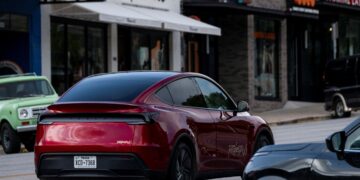After abandoning the in-house development of its autonomous vehicles in 2020, Uber is back in the race. But this time, the American giant is changing course: no more in-house projects, making way for a strategy based on technological and commercial partnerships. There are four of them this May.
Robot taxis appear to be the royal road to mass adoption of autonomous vehicles. According to a roadmap published by the World Economic Forum, 4% of passenger cars will be certified as level 4 autonomous by 2035. This level enables fully autonomous driving, but only in defined geographical or contextual conditions (unlike level 5, which has no restrictions).
This scenario fits perfectly with Uber’s business model, which is based on connecting users and fleets rather than on individual ownership. It would lead to lower prices and costs, as drivers account for 70% to 80% of the price of a ride. This growth lever has significant potential.
A strategy of alliances
Since 2023, Uber has been signing a number of agreements to expand its presence in the sector. The company was already completing 100,000 autonomous trips per week in the US last summer thanks to its partnership with Waymo (a subsidiary of Alphabet). The partnership began in Phoenix, the largest autonomous service area in the world at the time, and has since expanded to Austin and soon to Atlanta.
At the same time, the agreement with Avride, launched at the end of 2024, enables autonomous transportation and delivery services in Dallas and Jersey City. On the logistics side, Uber is also focusing on sidewalk robots for last-mile delivery.
On the technology front, Uber is relying on Nvidia to train its algorithms using Cosmos, an AI-based simulator. A partnership with Volkswagen plans to deploy thousands of ID. Buzz AD autonomous vehicles starting in 2026, beginning in Los Angeles.
Global expansion underway
Uber is not limiting itself to the US market. In Dubai, the platform is collaborating with WeRide and local authorities to integrate autonomous vehicles into the city’s mobility strategy. The agreement is expected to expand to 15 other cities in the coming years, including some in Europe.
This week, Uber also signed a partnership with May Mobility. The company will provide a fleet of hybrid-electric Toyota Siennas equipped with patented MPDM (Multi-Policy Decision Making) technology. Initially in Texas, the two companies have expressed their desire to roll out the service internationally.
In Europe, Uber is entering the market with China’s Momenta. This partnership marks the first milestone in its autonomous strategy on the Old Continent. In addition, an agreement signed on Tuesday with Pony AI provides for deployments in the Middle East, with a view to global expansion.
Notably, eight of the 12 strategic partnerships signed since 2020 were signed in 2025, including four in May alone.
Legislation still lagging behind in Europe
In terms of regulations, the European Union currently only allows level 3 vehicles, where the driver can let go of the wheel under certain conditions but must remain alert. Levels 4 and 5 are still in the testing phase. The European Parliament is talking about a gradual arrival on the market with wider commercialization starting in 2030.
Fierce competition
Faced with Uber, car manufacturers are making their moves. Tesla plans to launch a robotaxi, the Cybercab, by 2026 or 2027, and will offer unsupervised driving on its Model 3 and Y vehicles from 2025.
General Motors is gradually integrating its Super Cruise system into more than 20 models. Ford is aiming for hands-free driving by 2026, while Toyota is preparing an autonomous vehicle for the Chinese market for 2025.
Mercedes-Benz remains the leader in certification, with its Drive Pilot system approved for Level 3 in the United States (California, Nevada) and Germany. From 2025, the maximum speed limit will increase to 95 km/h. A “Level 2++” system, adapted to urban driving, will also be offered on the future CLA.
(Source: World Economic Forum )


















